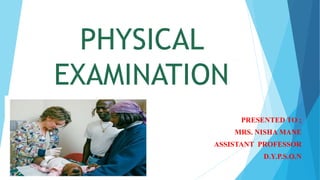This document provides guidelines for performing a comprehensive physical examination of children. It describes how to assess various body systems and structures including height, weight, temperature, skin, eyes, ears, nose, mouth, heart, lungs, abdomen, genitals, musculoskeletal system and nervous system. Physical examination is an important part of the nursing process as it provides data to identify any abnormalities and guide nursing diagnosis, care, and evaluation. The examination should be performed thoroughly but also make the child comfortable.








































